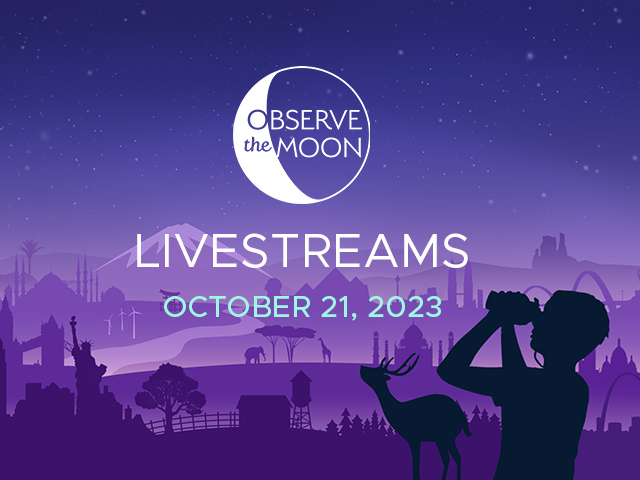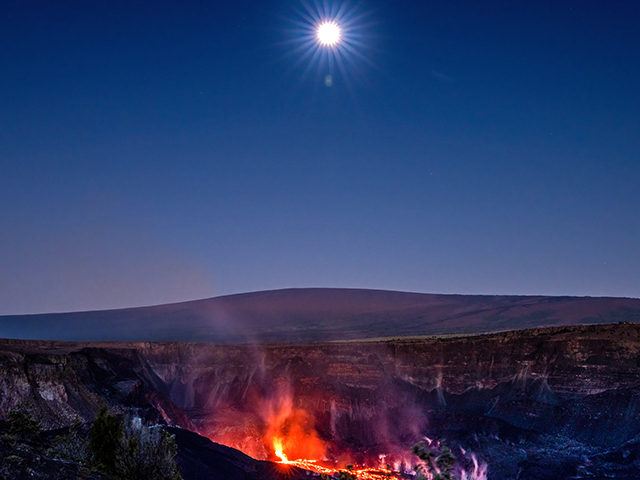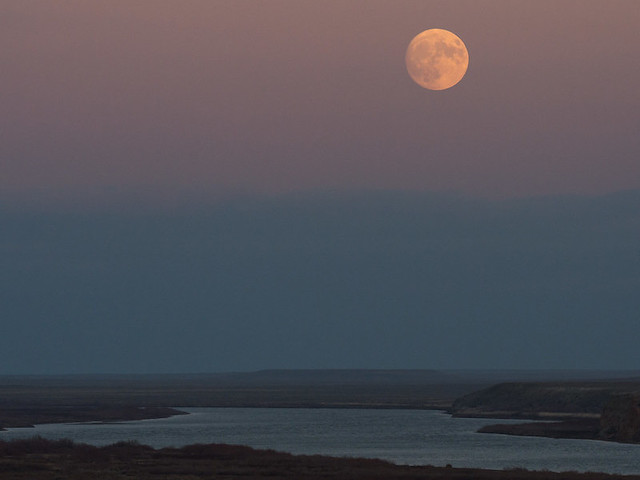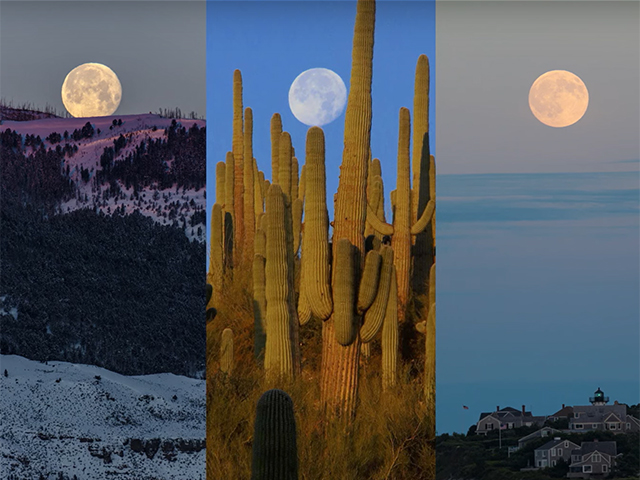News | August 23, 2018
Full Moon Blog: The Next Full Moon is the Corn, Sturgeon, Fruit, Barley, Hungry Ghost, Raksha Bandhan, or Nikini Moon
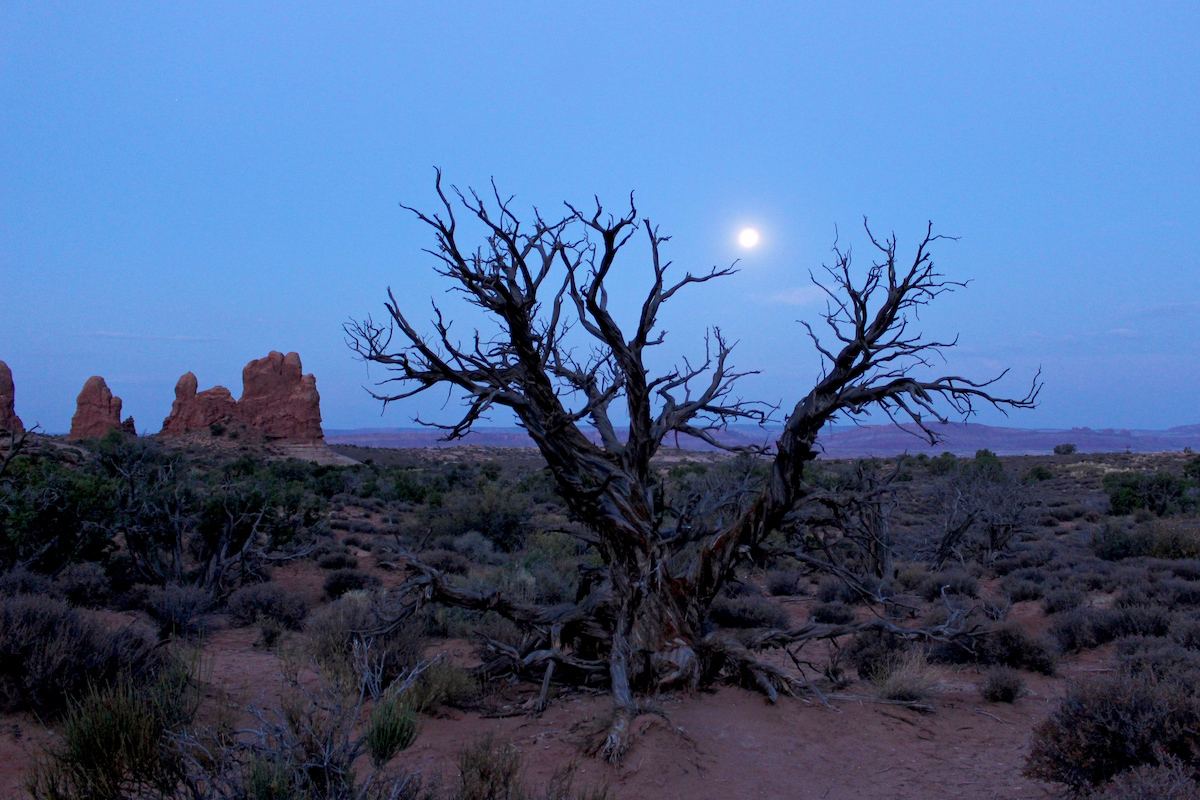
The Moon sets over the early morning desert in Arches National Park, Utah on July 28, 2018. Credit: NASA/Bill Dunford
The next full moon is the Corn Moon, the Sturgeon Moon, the Fruit Moon, the Barley Moon, the Hungry Ghost Moon, the Raksha Bandhan Moon, and the Nikini Moon.
The next full moon will be on Sunday morning, August 26, 2018, appearing "opposite" the Sun (in Earth-based longitude) at 7:56 AM EDT. The Moon will appear full for about three days centered around the this time, from Friday evening through Monday morning, making this a full moon weekend.
As the last full moon of Summer, the Native American tribes of what is now the Northeastern United States called this the Corn Moon, the time for gathering their main staple crops of corn, pumpkins, squash, beans, and wild rice. Since this full moon will be in August, some call this the Sturgeon Moon.
The Maine Farmer's Almanac first published Indian names for the full moons in the 1930's, and over time these names have become widely known and used. Many writers tie these Native American names to the European months, so that the full moon in August is the Sturgeon Moon, regardless of whether it is the second or the last full moon of Summer. It makes more sense to me that the Native American tribes tied their Moon names to the seasons (especially before Europeans settled in North America), with the second full moon of Summer the Sturgeon Moon and the last full moon of Summer the Corn Moon. Most of the time the names tied to months agree with the names tied to the seasons, but in January of 2018, we had two full moons in one month (a Blue Moon by the newer definition). This got these names out of sync. In the Spring of 2019 we will have a season with four full moons and this will get the names back in sync again. The full moon in May 2019 will be the "extra" Moon of the season, a Blue Moon by the older, more traditional definition. In any case, I expect that the Native American Moon names varied by tribe and region, as (for example) when the Strawberries or Sturgeons were abundant in the tribe's local area, and like lots of folk traditions, there is no single "right" answer.
Europeans called this full moon the Fruit Moon (as a number of fruits ripen as the end of Summer approaches) or the Barley Moon (for the harvesting and threshing of the barley).
This full moon corresponds to the Chinese Hungry Ghost Festival. The seventh month of the Chinese calendar is the Ghost Month and the fifteenth day of this month (a full moon day) is called Ghost Day, on which ghosts and spirits, including those of the deceased ancestors, come out to visit the living.
This full moon corresponds with the Hindu festival Raksha Bandhan, celebrating the bond between brothers and sisters. One of the traditions is for sisters of all ages to tie a rakhi (a cotton bracelet) around their brothers wrist, receiving a gift from the brother in return, as a sign of the continuing bond between them. The term "Raksha Bandhan" translates as "the bond of protection, obligation, or care."
Every full moon is a holiday in Sri Lanka. This full Moon corresponds with the Nikini Poya holiday, commemorating the first Buddhist council, which occurred about 2,400 years ago, sometime around 400 BCE.
In lunisolar calendars the months change with the new moon and full moons fall in the middle of the lunar month. This full moon is the middle of the Elul in the Hebrew calendar. Elul is a time of preparation for the High Holy Days of Rosh Hashanah and Yom Kippur. Customs include granting and asking others for forgiveness and beginning or ending all letters with the wish that the recipient will have a good year.
In the Islamic calendar the months start with the first sighting of the waxing crescent Moon a few days after the new moon. This full Moon is near the middle of Dhu al-Hijjah, the twelfth and final month of the Islamic year. By the night of the full moon two of the most important events in Islam will have ended, the Hajj or pilgrimage to Mecca and the 3-day Feast of the Sacrifice (Eid al-Adha), honoring the willingness of Ibrahim to sacrifice his son.
As usual, the wearing of suitably celebratory celestial attire is encouraged in honor of the full moon. And you might want to gather your fruits, vegetable and other staples; honor your ancestors; keep in touch with your siblings; ask for forgiveness; and let go of those old grudges. Here's wishing you have a good year!
Other Celestial Events
As for other celestial events between now and the full moon after next:
As Summer ends and Fall begins (for the Northern Hemisphere), the daily periods of sunlight shorten at their fastest rate. For the Washington, DC area, on the day of the full Moon on August 26, morning twilight will begin at 5:31 AM, sunrise will be at 6:32 AM, the Sun will reach a maximum altitude of 61.4 degrees at 1:10 PM, sunset will be at 7:47 PM, and evening twilight will end at 8:48 PM EDT. On the day of the autumnal equinox on September 22, 2018, morning twilight will begin at 5:58 AM, sunrise will be at 6:56 AM, the Sun will reach a maximum altitude of 51.3 degrees at 1:01 PM, sunset will be at 7:05 PM, and evening twilight will end at 8:03 PM EDT. By the day of the full Moon on September 24, morning twilight will begin at 6:00 AM, sunrise will be at 6:58 AM, the Sun will reach a maximum altitude of 50.5 degrees at 1:00 PM, sunset will be at 7:02 PM, and evening twilight will end at 7:59 PM EDT.
On the evening of the August full moon, as evening twilight ends (at 8:48 PM EDT for the Washington, DC area), the brightest of the planets, Venus, will appear in the west-southwest at about 6 degrees above the horizon. When Venus is visible in the evening, it is known as Hesperus, Vesper, or the Evening Star. Temporarily the second brightest planet in the sky, Mars will appear in the south-southeast at about 18 degrees above the horizon. Mars was at its closest and brightest in late July. Mars remains in a planet-wide dust storm, though the storm has begun to abate, masking the planet's surface features even with the biggest telescopes we have on Earth. The dust has cut down on the sunlight reaching the surface of Mars, shutting down the solar-powered Opportunity rover. Currently the third bright planet, Jupiter, will appear high in the southwest at about 20 degrees above the horizon. Jupiter was at its closest and brightest for the year in May, and remains bright. The planet Saturn will appear in the south at about 28 degrees above the horizon. Saturn was at its closest and brightest for the year in late June.
The "Summer Triangle" will be high in the east. The "Summer Triangle" is not a constellation but consists of three bright stars from three different constellations. Looking east, nearly overhead is Vega, the brightest star in the constellation Lyra the Harp; to the left is Deneb, the brightest star in the constellation Cygnus the Swan; and to the lower right is Altair, the brightest star in the constellation Aquila the Eagle.
As the month progresses the stars, along with Jupiter, Saturn, and Mars, will appear to shift more towards the west, while Venus will appear to shift along the horizon more towards the west-southwest. Even though Venus is becoming more and more of a crescent (when viewed with a telescope or binoculars) and shifting closer to the horizon, it is also shifting closer to the Earth, so it is continuing to increase in brightness and with reach its greatest brilliancy on September 25, 2018 ("greatest brilliancy" is an approximation for greatest brightness).
By the evening of the September full moon, as evening twilight ends (at 7:58 PM EDT for the Washington, DC area) Venus will be near its brightest but will be setting in the west-southwest (so you will need to look earlier, when the sky is still bright with dusk). Jupiter will have regained its customary position as the second brightest planet in the sky, appearing in the southwest about 12 degrees above the horizon. Mars as the third brightest planet will appear in the south-southwest about 25 degrees above the horizon. Saturn will appear between Mars and Jupiter at about 27 degrees above the horizon. The Summer Triangle will have shifted higher with Vega appearing nearly overhead.
On the morning of the August full moon, as morning twilight begins (at 5:31 AM EDT for the Washington, DC area), the only planet visible will be Mercury, in the east-northeast at about 5 degrees above the horizon. The bright stars of the local arm of our home galaxy, the Milky Way, including the Constellation Orion, will appear spread across the sky from east-southeast towards the west-northwest, where the Summer Triangle will be setting.
As the month progresses, Mercury will appear at its highest above the horizon at the time morning twilight begins on August 28, 2018, then shift towards the horizon until it is lost in the glow of dawn, passing on the far side of the Sun as seen from Earth from the morning sky to the evening sky on September 20, 2018. The bright stars of the local arm of our galaxy will appear to shift westward and higher in the sky.
This should still be a great time for planet watching, especially with a backyard telescope. Jupiter was at its closest and brightest for the year on May 8 2018, Saturn was at its closest and brightest on June 27, 2018, and Mars was at its closest and brightest at the end of July, 2018. Jupiter, Saturn, and Mars will continue to shift towards the west over the coming months, making them visible earlier in the evening sky (more suitable for sky watching with small children with earlier bedtimes). In the west, the brightest of the planets, Venus, will also grow in brightness, reaching its greatest brilliancy in late September 2018. With a small telescope you should be able to see Jupiter's four bright moons, Ganymede, Callisto, Europa, and Io, shifting positions noticeably in the course of an evening. Galileo was the first person known to point the newly developed telescope at Jupiter, and he immediately noticed these moons that we now call the Galilean moons. For Saturn, you should be able to see the brightly illuminated rings as well as the motions of Saturn's moons, particularly the large moon, Titan, which has an atmosphere and lakes of liquid methane. Venus will appear a little less than half-lit, and will gradually become brighter but more of a crescent as it shifts closer to Earth reaching its maximum brilliancy the evening after the full moon in September.
On Wednesday night into Thursday morning, August 22 to 23, 2018, the bright planet Mars will appear below the waxing gibbous Moon. Mars will appear to shift more to the left of the Moon until they set together (at 3:40 AM EDT for the Washington, DC area).
Even though they are not visible usually, I include in these Moon missives information about Near Earth Objects (mostly asteroids) that pass the Earth within about 20 lunar distances, because I find it interesting that we have discovered so many. Thursday morning, August 23, 2018 at 5:49 AM EDT (2018-Aug-23 09:49 UTC), Near Earth Object (2018 PW7), between 37 and 82 meters (120 to 269 feet) in diameter, will pass the Earth at between 11.1 and 11.4 lunar distances (nominally 11.3), traveling at 10.56 kilometers per second (23,629 miles per hour).
Thursday morning, August 23, 2018, at 7:23 AM EDT, the Moon will be at apogee, its farthest from the Earth for this orbit.
Thursday afternoon, August 23, 2018 at about 4:57 PM EDT (2018-Aug-23 20:57 UTC with 4 minutes uncertainty), Near Earth Object (2018 PU23), between 6 and 14 meters (21 to 47 feet) in diameter, will pass the Earth at 7.8 lunar distances, traveling at 1.47 kilometers per second (3,280 miles per hour).
Thursday evening, August 23, 2018, the Moon will appear such that the bright planet Mars will appear to the lower right of the Moon. Mars will set Friday morning (at 3:36 AM EDT for the Washington DC area) and the Moon will set (at 4:45 AM).
Friday morning, August 24, 2018 at around 8:21 AM EDT (2018-Aug-24 12:21 UTC with 44 minutes uncertainty), Near Earth Object (2018 PR9), between 35 and 78 meters (115 to 257 feet) in diameter, will pass the Earth at between 17.1 and 18.9 lunar distances (nominally 18.0), traveling at 14.03 kilometers per second (31,387 miles per hour).
As mentioned above, the next full moon will be on Sunday morning, August 26, 2018, at 7:56 AM EDT.
On the day of the full moon, the planet Mercury will be at its greatest angular separation from the Sun as seen from the Earth in the morning sky. For the Washington, DC area (and similar latitudes), Mercury will appear at its greatest elevation above the horizon at the time morning twilight begins a few days later, on Tuesday, August 28, 2018.
Monday afternoon, August 27, 2018 at 5:35 PM EDT (2018-Aug-27 21:35 UTC), Near Earth Object (2018 LQ2), between 29 and 65 meters (96 to 214 feet) in diameter, will pass the Earth at 9.4 lunar distances, traveling at 1.49 kilometers per second (3,332 miles per hour).
Tuesday mid-day, August 28, 2018 at around 12:31 PM EDT (2018-Aug-28 16:31 UTC with 45 minutes uncertainty), Near Earth Object (2016 GK135), between 6 and 14 meters (21 to 47 feet) in diameter, will pass the Earth at 16.7 lunar distances, traveling at 2.75 kilometers per second (6,156 miles per hour).
Tuesday night, August 28, 2018 at 11:38 PM EDT (2018-Aug-29 03:38 UTC), Near Earth Object (2016 NF23), between 70 and 156 meters (229 to 513 feet) in diameter, will pass the Earth at 13.1 lunar distances, traveling at 9.04 kilometers per second (20,227 miles per hour).
Wednesday morning, August 29, 2018 at 3:27 AM EDT (2018-Aug-29 07:27 UTC), Near Earth Object (1998 SD9), between 38 and 86 meters (126 to 282 feet) in diameter, will pass the Earth at 4.2 lunar distances, traveling at 10.70 kilometers per second (23,934 miles per hour).
Thursday mid-day, August 30, 2018 at around 11:30 AM EDT (2018-Aug-30 15:30 UTC with 1 hour 11 minutes uncertainty), Near Earth Object (2018 DE1), between 21 and 47 meters (69 to 155 feet) in diameter, will pass the Earth at between 14.6 and 15.8 lunar distances (nominally 15.2), traveling at 6.48 kilometers per second (14,502 miles per hour).
On Friday evening, August 31, 2018, the bright planet Venus will appear in the west-southwest, just below the bright star Spica. For the Washington, DC area, as evening twilight ends (at 8:40 PM EDT), Venus will appear about 5.5 degrees above the horizon, with Spica appearing a little over a degree above Venus. Venus will set at 9:13 PM and Spica will set about 7 minutes later.
Sunday morning, September 2, 2018 at 8:05 AM EDT (2018-Sep-02 12:05 UTC), Near Earth Object (2001 RQ17), between 80 and 179 meters (263 to 589 feet) in diameter, will pass the Earth at 19.3 lunar distances, traveling at 8.27 kilometers per second (18,499 miles per hour).
Sunday evening, September 2, 2018, the waning Moon will appear half-full as it reaches its last quarter at 10:37 PM EDT. The Moon is naturally like a bicycle reflector, reflecting more light back towards a light source and less off at large angles away from a light source. In addition, there are fewer dark areas on the left side of the Moon than on the right side of the Moon (as seen from the Northern Hemisphere), so even though the Moon appears half-lit, the waning half-moon is only about 12% as bright as the full moon.
Early Monday morning, September 3, 2018, the bright star Aldebaran will appear to the right of the half-full moon. For the Washington, DC area, Aldebaran will rise in the east-northeast just before midnight on Sunday night, September 2, 2018, the Moon will rise just after midnight on Monday morning, September 3, 2018, and the pair will appear to separate until Aldebaran is lost in the glow of dawn, with morning twilight starting around 5:39 AM EDT.
Monday morning, September 3, 2018 at 6:09 AM EDT (2018-Sep-03 10:09 UTC with), Near Earth Object (2015 FP118), between 367 and 820 meters (1,204 to 2,692 feet, about a quarter to a half mile) in diameter, will pass the Earth at 12.2 lunar distances, traveling at 9.77 kilometers per second (21,845 miles per hour).
Monday mid-day, September 3, 2018 at around 12:51 PM EDT (2018-Sep-03 16:51 UTC with 1 hour uncertainty), Near Earth Object (2018 QA), between 56 and 124 meters (182 to 407 feet) in diameter, will pass the Earth at between 16.2 and 18.6 lunar distances (nominally 17.4), traveling at 20.37 kilometers per second (45,572 miles per hour).
Friday evening, September 7, 2018, at 9:21 PM EDT, the Moon will be at perigee, its closest to the Earth for this orbit.
On Sunday morning, September 8, 2018, if you have a clear view of the horizon in the east-northeast, you might be able to see the very thin, crescent, waning Moon, a few degrees above the bright star Regulus, with the planet Mercury below. For the Washington, DC area, the Moon will rise at 5:10 AM, Regulus will rise at 5:26 AM, and Mercury will rise just around the time morning twilight begins (at about 5:44 AM EDT),
Sunday, September 9, 2018, at 2:01 PM EDT, will be the new Moon, when the Moon passes between the Earth and the Sun and will not be visible from the Earth.
In most lunisolar calendars the new month starts with the New Moon. In the Hebrew calendar the days start with sunset, so Sunday evening marks the start Rosh Hashanah, the Hebrew New Year celebration and the start of the first month of the Jewish civil year, Tishrei. The tenth day of Tishrei is Yom Kippur, the Day of Atonement.
In the traditional Chinese calendar days begin at midnight and the day of the New Moon is the first day of the new month, so this is the start of the eighth month in the Chinese calendar.
In the Islamic calendar the months start with the first sighting of the waxing crescent Moon after the New Moon. Tuesday evening, September 11, 2018, should mark the beginning of Muharram, the first month of the year, one of the sacred months in which warfare is forbidden.
On Thursday evening, September 13, 2018, the bright planet Jupiter will appear to the lower left of the waxing crescent Moon. For the Washington, DC area, evening twilight will end at 8:18 PM, Jupiter will set at 9:51 PM, and the Moon will set at 10:02 PM EDT.
On Sunday, September 16, 2018, the Moon will appear half-full as it reaches its first quarter at 7:15 PM EDT. The Moon is naturally like a bicycle reflector, reflecting more light back towards a light source and less off at large angles away from a light source. In addition, there are more dark areas on the right side of the Moon than on the left side of the Moon (as seen from the Northern Hemisphere), so even though the Moon appears half-lit, the waxing half-moon is only about 10% as bright as the full Moon.
On Monday night, September 17, 2018, the planet Saturn will appear to the lower right of the waxing gibbous Moon. Saturn will set about 16 minutes after midnight on Tuesday morning, and the Moon will set about a half hour later.
Wednesday evening, September 19, 2018, at 8:54 PM EDT, the Moon will be at apogee, its farthest from the Earth for this orbit.
On Wednesday evening, September 19, into Thursday morning, September 20, 2018, the bright planet Mars will appear below the waxing gibbous Moon. For the Washington, DC area, evening twilight will end Wednesday night at 8:08 PM, the Moon will reach its highest in the sky for the evening at 9:24 PM, Mars will set in the west-southwest at 2:13 AM Thursday morning, and the Moon will set at 2:28 AM EDT.
Thursday afternoon, September 20, 2018 at 5:09 PM EDT (2018-Sep-20 21:09 UTC), Near Earth Object (2017 SL16), between 18 and 41 meters (60 to 135 feet) in diameter, will pass the Earth at between 8.3 and 8.7 lunar distances (nominally 8.5), traveling at 6.42 kilometers per second (14,360 miles per hour).
Thursday evening, September 20, 2018, will be when the planet Mercury passes around the far side of the Sun as seen from the Earth, moving from the morning sky to the evening sky.
Saturday evening, September 22, 2018, at 9:54 PM EDT, will be the autumnal equinox, the astronomical end of Summer and start of Fall.
The full moon after next will be on Monday evening, September 24, 2018 at 10:52 PM EDT. As the full moon nearest the autumnal equinox, this will be the Harvest Moon.


